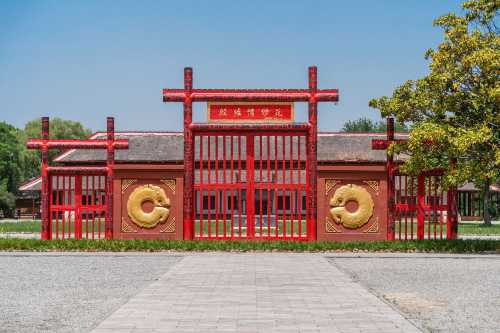App
Customer Support
NZD
Find Bookings
Popular Trip Moments
🏔️ Hidden Gem Near Beijing & Tianjin | Stunning Taihang Grand Canyon 🌿 | Hidden Divine Courtyard in Anyang, Henan! | Anyang: Tangyin Museum, a Thousand-Year-Old County. | Anyang | Two Jinshi Scholars from One Family: The Mashi Manor. | Qingming Festival Getaway|A 2.5-Hour High-Speed Rail Trip from Beijing to a Living History Textbook | 6 days of sightseeing in Kaifeng and other places, you must check in at these attractions | A Super Comprehensive Guide to a 6-Day Tour of Anyang and Other Areas—Don't Miss Out! | 6-Day Tour of Anyang and Surrounding Areas|A Foolproof Guide | Zhengzhou-Anyang-Linzhou Travel Guide for Seniors: Enjoy a Relaxing Trip | 3-Day Linzhou Itinerary for the Short Holiday | The Red Flag Canal: A Breathtaking Feat of Human Ingenuity | A must-visit destination! Truly amazing! | Orange Hotel (Anyang Government Wanda Plaza Branch) Grand Opening | A Super Detailed Guide to Luoyang for Seniors—A Must-Have for Parents' Trips | Henan-Shanxi 6-Day Tour: The Perfect Qingming Festival Getaway—A Super Detailed Guide | The Taihang Mountains, a thousand-mile spine across the Central Plains! | A City Walk in Luoyang and Other Places Was So Amazing, I Didn't Want to Go Home | Exploring the "Artificial Sky River": A Complete Guide to Traveling to the Red Flag Canal | Journey Through the Taihang Mountains: An Epic Encounter with Nature's Majesty | Winter Break Travel Guide: Xinxiang-Luoyang-Jiaozuo | Xiao Nanhai: Henan's "Immortal Mountain on the Sea" | Lingquan Temple Grottoes, also known as Wanfogou, Xiaolongmen | Anyang Museum—A Comprehensive History Museum and National First-Class Museum | Yinxu Museum | The Great Shang Civilization - Yinxu | 9-Day Tour of Luoyang and Other Destinations: Detailed Guide to a Legendary Trip | Taihang Grand Canyon | The budget traveler was so excited that he cried. You must stay at this hotel when you come to Taihang Mountains! ! ! | Shibanyan Town, Linzhou, Anyang | Anyang Museum | Henan_Anyang
Popular Travel Types
Recommended Attractions at Popular Destinations
Bangkok attraction near me | Manila attraction near me | Tokyo attraction near me | Taipei attraction near me | Hong Kong attraction near me | Seoul attraction near me | Kuala Lumpur attraction near me | Los Angeles attraction near me | Shanghai attraction near me | New York attraction near me | Shenzhen attraction near me | Osaka attraction near me | Singapore attraction near me | London attraction near me | Guangzhou attraction near me | San Francisco attraction near me | Beijing attraction near me | Macau attraction near me | Bali attraction near me | Jakarta attraction near me | Paris attraction near me | Ho Chi Minh City attraction near me | Istanbul attraction near me | Phuket attraction near me | Chicago attraction near me | Seattle attraction near me | Toronto attraction near me | Orlando attraction near me | Cebu attraction near me | Chiang Mai attraction near me
Popular Attractions
Manila Ocean Park | Bell Tower and Drum Tower Square | Laoniuwan Yellow River Grand Canyon Tourist Area | Hui Fang | Universal Studios Singapore | Anyuan Gate | Niushou Mountain | Chimelong Paradise | Jiufen Old Street | Trojan Horse Statue | Westcoast Treetop Walk & Tower Zipline | USS Midway Museum | Farm Tomita | Chongqing Two Rivers Night Tour | Chaoyang Theatre Acrobatic Show | Oriental Pearl Radio & Television Tower | Bangchui Island | North Bridge | Temba Arena | Bingyu Valley | Stade de football | Library De Mercuer | Chidambara Swamigal Temple | Marktplatz | Ginkgo Gem Shop | National Nature Reserve Beauguillot | Maharana Pratap Statue | Ujung tebing breksi | Z Day Spa | The Central square of Karditsa
Popular Restaurants in Anyang
Hello Cake你好蛋糕(万城华府店) | SURPRISE喜派甜品蛋糕 | Shi'erzuoronghe Restaurant | Bantianyao Grilled Fish (anyangwanda) | 多士多多 | 甲乙丁书店 | 真鱿味铁板烧(义乌店) | 蒲公英(德隆街店) | CoCo都可(中华路万达店) | Burger King (wanda) | MEI GUI GU YI WU DIAN | 悦见喜慕冻酸奶店 | Maitianwenhou | PUGLIA RESTAURANT | Feideiqing Braised chicken steamed sice (wandajinjie) | JIA FENG LAO GUAN ZI | 左右蛋糕(永明路店) | 万达嘉华酒店美食汇西餐厅 | 面包出炉啦(永明路店) | DQ | 卧龙大酒店(永安街店) | 巫山纸包鱼(富泉街店) | BI SHENG KE ZHONG HUA LU DIAN | Shengdeli (dongqu) | WE.FINEST DINING | 鸭百味·味道名厨烤鸭酒店(德隆街店) | 同来顺(解放路店) | 巴奴毛肚火锅(金豪店) | 庭湖之湘(东风路店) | 巴奴毛肚火锅(相州店)
Popular Ranked Lists
Popular Best Things to Do in Guang'an | Top 5 Local Restaurants in Xuancheng | Top 10 Local Restaurants in Cixi | Top 4 Local Restaurants in Baoji | Top 7 Best Things to Do in Jining | Top 3 Best Things to Do in Bazhong | Popular Premium Hotels in Limburg | Popular Best Things to Do in Cangzhou | Top 3 Best Things to Do in Sanmenxia | Top 6 Best Things to Do in Yi County | Top 4 Premium Hotels in Vung Tau | Popular Best Things to Do in Danba | Top 3 Best Things to Do in Zaozhuang | Top 9 Local Restaurants in Lushan Global Geopark | Popular Premium Hotels in Caloundra | Top 4 Best Things to Do in Fangchenggang | Popular Best Things to Do in Wuhai | Popular Premium Hotels in King Island | Top 10 Local Restaurants in Yibin | Popular Best Things to Do in Luanping | Popular Local Restaurants in Anqing | Popular Premium Hotels in Pokolbin | Top 10 Local Restaurants in Baotou | Popular Best Things to Do in Jingmen | Popular Premium Hotels in Sivaganga | Top 3 Local Restaurants in Lu'an | Top 4 Best Things to Do in Jinjiang | Top 10 Local Restaurants in Wanning | Top 11 Local Restaurants in Zhenjiang | Top 4 Best Things to Do in Nanyang
Payment Methods
Our Partners
Copyright © 2025 Trip.com Travel Singapore Pte. Ltd. All rights reserved
Site Operator: Trip.com Travel Singapore Pte. Ltd.
Site Operator: Trip.com Travel Singapore Pte. Ltd.



























